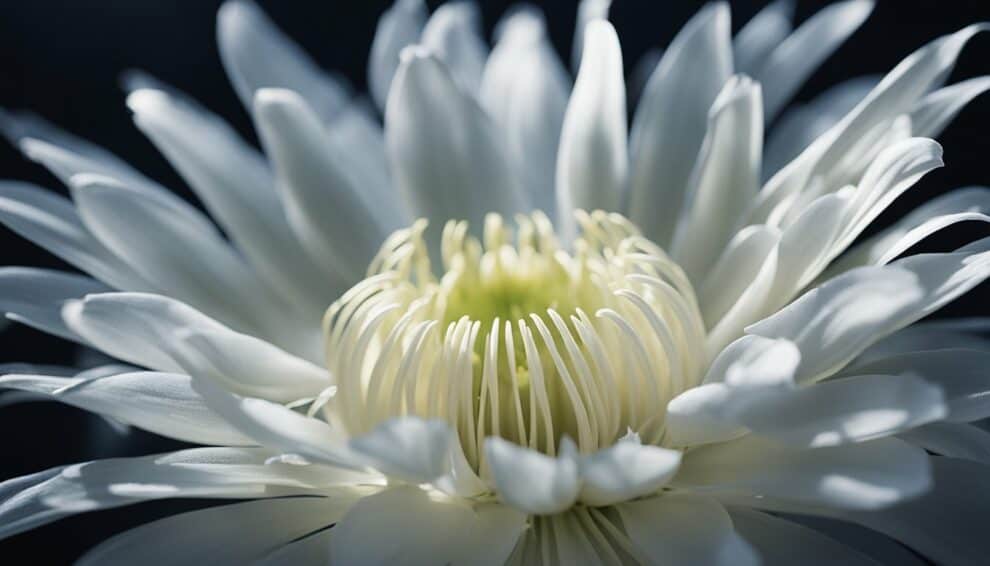Selenicereus Grandiflorus, also known as Queen of the Night, is a unique and beautiful plant that has captured the attention of many gardeners.
With its large, fragrant blooms that only open at night, this plant is a true wonder of nature.
However, caring for Selenicereus Grandiflorus can be a challenge, and many people struggle to keep their plants healthy and thriving.

In this article, readers will learn all about the secrets of Selenicereus Grandiflorus care.
From choosing the right soil and pot to providing the ideal growing conditions, this guide will provide all the information needed to help this plant thrive.
Whether you are a seasoned gardener or just starting out, this article is sure to offer valuable insights and tips for growing Queen of the Night successfully.
So if you are looking to unlock the secrets of Selenicereus Grandiflorus care and enjoy the beauty of its stunning blooms, read on to discover everything you need to know.
Discovering Selenicereus Grandiflorus
Historical Significance
Selenicereus Grandiflorus, also known as the Queen of the Night, is a cactus species native to Central and South America.
The plant has been cultivated for centuries due to its beautiful, fragrant flowers that bloom only at night.
The Aztecs, for instance, used the plant in their religious ceremonies, believing it to have supernatural powers.
In the 19th century, the plant became popular in Europe as a symbol of love and passion.
It was often given as a gift to express romantic feelings, and its popularity continued to grow throughout the years.
Today, the Queen of the Night is a beloved plant in many parts of the world, prized for its stunning blooms and unique characteristics.
Botanical Profile
Selenicereus Grandiflorus is a climbing cactus that can grow up to 30 feet in length.
It has long, flat stems with serrated edges that are covered in small, hair-like spines.
The plant produces large, fragrant flowers that open at night and close in the morning.
The flowers are usually white, but they can also be pink, yellow, or red, depending on the variety.
The Queen of the Night is a relatively easy plant to care for, but it does require specific conditions to thrive.
It prefers well-draining soil and bright, indirect light. It should be watered sparingly, as overwatering can cause root rot.
The plant also benefits from regular fertilization during the growing season.
Overall, Selenicereus Grandiflorus is a fascinating and beautiful plant with a rich history and unique characteristics.
With proper care, it can provide years of enjoyment and beauty for plant enthusiasts around the world.
Essential Care Guide

Lighting Requirements
Queen of the Night thrives in bright but indirect light.
Direct sunlight can cause the plant to burn, so it’s best to place it in a spot where it can receive bright, filtered light.
If you’re growing the plant indoors, consider placing it near a window that faces east or west.
This will provide enough light for the plant to grow without exposing it to direct sunlight.
Watering Techniques
Selenicereus Grandiflorus requires moderate watering. Overwatering can cause root rot, while underwatering can cause the plant to wilt.
Water the plant when the top inch of soil feels dry to the touch. Use a watering can with a long spout to water the plant slowly and evenly.
Make sure the water drains out of the pot completely to avoid waterlogging the soil.
Soil and Fertilization
Queen of the Night prefers well-draining soil that is rich in organic matter.
Use a potting mix that contains peat moss, perlite, and vermiculite to ensure good drainage.
Fertilize the plant once a month during the growing season with a balanced fertilizer. Avoid fertilizing the plant during the dormant season.
Temperature and Humidity Needs
Selenicereus Grandiflorus prefers warm temperatures between 60°F and 80°F. Keep the plant away from cold drafts and air conditioning vents.
The plant also prefers high humidity levels.
Consider placing a humidifier near the plant or placing a tray of water near the plant to increase the humidity in the air.
Propagation and Growth

Propagation Methods
Selenicereus grandiflorus is propagated using stem cuttings.
It is recommended to take cuttings in the spring or summer months when the plant is actively growing.
Cuttings should be taken from healthy, mature stems that have at least two nodes.
The cuttings should be allowed to dry for a few days before planting to prevent rotting.
Once the cuttings have dried, they can be planted in well-draining soil. It is important to keep the soil moist but not waterlogged.
Rooting hormones can be used to encourage root growth.
Growth Patterns and Stages
Selenicereus grandiflorus is a fast-growing plant that can reach up to 20 feet in length.
It is a climbing plant that attaches itself to trees or other structures using aerial roots.
The plant produces long, flat stems with prominent, spiny ridges.
During the growing season, Selenicereus grandiflorus produces large, fragrant flowers that bloom at night.
The flowers are white and can be up to 12 inches in diameter. The plant requires full sun to partial shade and well-draining soil.
As the plant grows, it will require support to prevent it from falling over. A trellis or other support structure can be used to provide support.
Regular pruning is also recommended to maintain the plant’s shape and promote healthy growth.
In conclusion, propagating and growing Selenicereus grandiflorus requires proper care and attention.
By following the recommended propagation methods and providing the plant with the necessary conditions for growth, it can thrive and produce beautiful flowers.
Troubleshooting Common Issues

Pests and Diseases
Selenicereus Grandiflorus is generally a hardy plant, but it can be susceptible to pests and diseases.
Here are some common issues to look out for and how to address them:
Mealybugs
Mealybugs are small, white, cotton-like insects that feed on the sap of the plant. They can cause stunted growth and yellowing of the leaves.
To get rid of them, use a cotton swab dipped in rubbing alcohol to wipe them off the plant.
You can also use insecticidal soap or neem oil to get rid of them.
Scale Insects
Scale insects are small, oval-shaped insects that attach themselves to the plant and suck the sap out of it.
They can cause yellowing of the leaves and stunted growth. To get rid of them, use a cotton swab dipped in rubbing alcohol to wipe them off the plant.
You can also use insecticidal soap or neem oil to get rid of them.
Root Rot
Root rot is a fungal disease that affects the roots of the plant. It can cause the leaves to wilt and turn yellow.
To prevent root rot, make sure the plant is not overwatered and that the soil is well-draining.
If you suspect root rot, remove the plant from the soil and inspect the roots.
If they are brown and mushy, cut off the affected roots and repot the plant in fresh soil.
Environmental Stress Factors
Selenicereus Grandiflorus can also be affected by environmental stress factors. Here are some common issues to look out for and how to address them:
Insufficient Light
Selenicereus Grandiflorus requires bright, indirect light to thrive. If the plant is not getting enough light, the leaves may turn yellow and drop off.
Move the plant to a brighter location, but avoid direct sunlight.
Temperature Fluctuations
Selenicereus Grandiflorus prefers warm temperatures between 60-80°F.
If the plant is exposed to temperature fluctuations, it can cause the leaves to wilt and turn yellow.
Keep the plant in a location with consistent temperatures.
Overfertilization
Overfertilization can cause the leaves to turn yellow and drop off. Use a balanced fertilizer and follow the instructions on the package.
Avoid fertilizing the plant during the winter months when it is dormant.
By addressing these common issues, you can keep your Selenicereus Grandiflorus healthy and thriving.
Frequently Asked Questions

How often should I water my Selenicereus grandiflorus for optimal growth?
Queen of the Night cacti prefer well-draining soil, so it is essential to water them only when the soil is dry to the touch.
Overwatering can cause root rot and hinder growth. During the growing season, water once a week, and reduce watering during the dormant season.
What are the ideal lighting conditions for a Queen of the Night plant?
Queen of the Night cacti thrive in bright, indirect sunlight. They can tolerate some direct sunlight, but too much can cause sunburn.
During the growing season, provide at least six hours of bright, indirect sunlight per day.
During the dormant season, reduce light exposure to encourage blooming.
Can you explain the blooming cycle of the Queen of the Night flower?
The Queen of the Night cactus blooms only at night and usually once a year.
The blooming cycle typically occurs during the summer, and the flower lasts for only one night.
The plant produces a sweet fragrance to attract pollinators, such as moths and bats.
What is the significance of the Queen of the Night flower in different cultures?
The Queen of the Night cactus is a symbol of love, beauty, and mystery in many cultures.
In Mexico, the plant is known as “La Reina de la Noche” and is often associated with the Virgin Mary.
In some cultures, the flower is believed to bring good luck and prosperity.
What should I do if my Queen of the Night plant doesn’t bloom?
If your Queen of the Night cactus does not bloom, it may be due to insufficient light exposure or over-fertilization.
Reduce fertilizer application and increase light exposure during the growing season.
During the dormant season, reduce light exposure and allow the plant to rest.
How do I propagate a Queen of the Night cactus successfully?
Propagation of the Queen of the Night cactus can be done through stem cuttings.
Cut a healthy stem from the parent plant and allow it to callus over for a few days.
Plant the cutting in well-draining soil and water sparingly until new growth appears.














